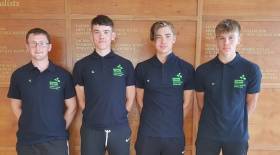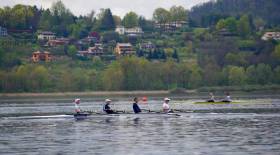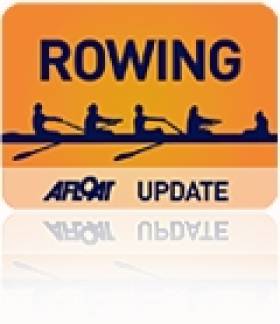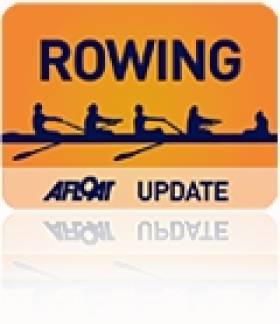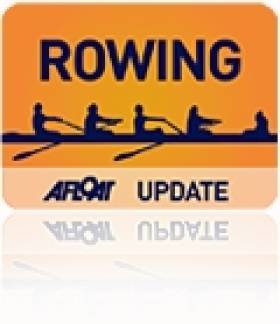Displaying items by tag: Four
Fifth for Ireland Four at Coupe Rowing in Belgium
#Rowing: Ireland’s crew of Aaron Johnston, Ross Corrigan, Barry Connolly and Nathan Timoney finished fifth in the A Final of the men’s four at the Coupe de la Jeunesse in Hazewinkel today. Britain, Switzerland and the Czech Republic took the gold, silver and bronze, with hosts Belgium fourth and Italy sixth.
Ireland have three other crews in A Finals this afternoon.
Coupe de la Jeunesse, Hazewinkel, Day One (Irish interest)
Junior Men
Four – Heat One (First Three to A Final): 3 Ireland (A Johnston, R Corrigan, B Connolly, N Timoney) 6:23.78. A Final: 5 Ireland 6:27.89.
Quadruple – Heat One: 1 Ireland (B O’Flynn, M Dundon, J Keating, J Quinlan) 6:12.81
Junior Women
Single Sculls – Heat Two (First Three to A Final): 1 Ireland (G O’Brien) 8:10.17.
Jennings and Lambe Bound for C Final at World Cup
#Rowing: The Ireland lightweight double of Sinéad Jennings and Claire Lambe finished fourth in their repechage and are bound for a C Final of the World Cup in Varese in Italy. Italy One and Italy Two battled it out at the head of the field, while Ireland lost a battle for the third qualification spot to Sweden.
The Ireland men’s lightweight four finished fifth in their repechage, rowed as conditions became tougher. The Ireland women’s pair of Leonora Kennedy and Barbara O’Brien also finished fifth in their repechage and also go to a C Final.
World Cup Regatta, Varese (Selected Results, Irish interest)
Men
Lightweight Four – Heat Three (First Two to A/B Semi-Final; rest to Repechages): 1 Italy Two 6:00.40, 2 United States 6:00.95; 4 Ireland (L Seaman, M O’Donovan, L Keane, S O’Driscoll) 6:18.75. Repechage One (First Three to A/B Semi-Finals; rest to C Final): Poland One 6:01.07, 2 Japan One 6:02.92, 3 Poland Two 6:03.41; 5 Ireland 6:14.13.
Lightweight Double Sculls – Heat Three (First Two to A/B Semi-Final; rest to Repechages): 1 Ireland (P O’Donovan, G O’Donovan) 6:27.07, 2 Britain 6:33.38; 3 Netherlands Two 6:48.24.
Women
Pair – Heat One (First Two to A/B Semi-Final; rest to Repechages): 1 Germany 7:23.08, 2 Russia One 7:24.46; 5 Ireland (L Kennedy, B O’Brien) 7:46.38. Repechage Two (First Three to Repechages; rest to C Final): 5 Ireland 7:24.68.
Lightweight Double Sculls – Heat Two (First Two to A/B Semi-Final; rest to Repechages): 1 Switzerland 7:03.98, 2 Canada 7:04.45; 3 Ireland (C Lambe, S Jennings) 7:05.0. Repechage One (First Three to A/B Semi-Finals; rest to C Final): 1 Italy One 6:57.42, 2 Italy Two 6:59.61, 3 Sweden One 7:01.20; 4 Ireland 7:05.60.
Single Sculls – Heat One (Winner to A/B Semi-Finals; rest to Repechages): 1 Ireland (S Puspure) 7:34.32; 2 Czech Republic (M Knapkova) 7:36.13.
Lightweight Single Sculls – Heat One (First Two to A/B Semi-Final; rest to Repechages): 1 Netherlands Two 7:40.25, 2 Italy 7:45.99; 4 Ireland Two (S McCrohan) 8:02.38.
Heat Two (First Two to A/B Semi-Final; rest to Repechages): 1 Canada 7:42.41, 2 Netherlands One 7:45.30; 5 Ireland One (D Walsh) 8:11.91.
Tenth Places for Two Ireland Crews at World Rowing Championships
#ROWING: Ireland’s men’s lightweight pair finished fourth in their B Final, 10th overall, at the World Rowing Championships in Amsterdam today. China won in a fast time in tailwind conditions, with Bulgaria and the Netherlands battling each other and finishing second and third. Ireland’s Niall Kenny and Mark O’Donovan were fifth through the middle stages but won their own battle with Austria to take a clear fourth.
The women’s four of Marie O'Neill, Emily Tormey, Aifric Keogh and Barbara O'Brien were fourth in their B Final, behind the Netherlands, who won impressively from Italy, with Germany third.
World Rowing Championships, Amsterdam, Day Six (Irish interest, selected results)
Men
Lightweight Pair – B Final (Places 7 to 12): 1 China (Zhenwei Hou, Fangbing Zhang) 6:28.29, 2 Bulgaria 6:30.40, 3 Netherlands 6:31.01, 4 Ireland (M O’Donovan, N Kenny) 6:34.06, 5 Austria 6:37.65, 6 Chile 6:43.01.
Women
Four – B Final (Places 7 to 10): 1 Netherlands 6:28.95, 2 Italy 6:35.51, 3 Germany 6:37.90, 4 Ireland (M O’Neill, E Tormey, A Keogh, B O’Brien) 6:43.62.
Lightweight Double Sculls – C Final (Places 13 to 18): 1 Russia (D Stepochkina, O Arkadova) 6:58.21, 2 Ireland (C Lambe, D Walsh) 7:00.11, 3 Denmark 7:03.49, 4 Switzerland 7:03.51, 5 Belarus 7:09.08, 6 Greece 7:14.20.
#ROWING: Sanita Puspure took her place in the semi-finals of the women’s single sculls at the World Rowing Championships in Amsterdam today. The 32-year-old led for most of the race but was passed by Russian veteran Julia Levina (41) in the final quarter.
The Ireland women’s four found the going tough again in their repechage and will compete in the B Final of this 10-boat event. Canada and the Ukraine took the two places available in the A Final, while Ireland finished sixth.
World Rowing Championships, Day Four (Selected Results; Irish interest)
Men
Lightweight Single Sculls – Quarter-Final (First Three to A/B Semi-Finals; rest to C/D Semi-Finals): 1 Germany (L Hartig) 7:13.67, 2 Ireland (P O’Donovan) 7:14.76, 3 Denmark (S Jensen) 7:33.91; 4 Azerbaijan 7:25.84, 5 Russia 7:33.91, 6 Algeria 7:43.76.
Women
Four – Repechage (First Two to A Final; rest to B Final): 1 Canada 7:03.51, Ukraine 7:05.31; 3 Netherlands 7:06.85, 4 Germany 7:10.32, 5 Italy 7:17.82, 6 Ireland (M O’Neill, E Tormey, A Keogh, B O’Brien) 7:22.82.
Double Sculls – Repechage Three (First Two to A/B Semi-Final: rest to C/D Semi-Final): 1 United States (M O’Leary, E Tomek) 7:18.10, 2 Ireland (H Hannigan, M Dukarska) 7:21.14; 3 Romania 7:22.87, 4 Estonia 7:48.85.
Single Sculls – Quarter-Final Three (First Three to A/B Semi-Final; rest to C/D Semi-Finals): 1 Russia (J Levina) 8:00.54, 2 Ireland (S Puspure) 8:02.31, 3 Lithuania (L Saltyte) 8:08.41; 4 Belarus 8:24.58, 5 Norway 8:25.56, 6 Hungary 8:29.50.
Fourth for Hannigan and Dukarska in First World Rowing Test
#ROWING: The new Ireland women’s double scull of Monika Dukarska and Helen Hannigan (neé Walshe) took fourth in their heat at the World Rowing Championships in Amsterdam today. Lithuania and the Ukraine fought it out at the head of the field, with Lithuania pulling away at the end. Ireland were in third at 1500 metres but yielded this to Denmark at the finish.
The Ireland women’s four were off the pace in their heat and finished fifth. The New Zealand four were extremely impressive in their win, and France held off Canada to take the second qualification spot for the A Final.
World Rowing Championships, Amsterdam, Day Two (Selected Results, Irish interest)
Men
Lightweight Pair – Heat Two (First Two to A/B Semi-Finals; rest to Repechage): 1 Ireland (M O’Donovan, N Kenny) 6:53.54, 2 China (Zhenwei Hou, Fanbing Zhang) 6:54.57; 3 Switzerland 7:03.74, 4 Australia 7:10.31, 5 Bulgaria 7:13.05, 6 Austria 7:19.39.
Women
Four – Heat One (First Two to A Final; rest to Repechage): 1 New Zealand 6:46.42, 2 France 7:01.16; 3 Canada 7:03.68, 4 Italy 7:09.17, 5 Ireland (M O’Neill, E Tormey, A Keogh, B O’Brien) 7:19.28.
Double Sculls – Heat One (Winner to A/B Semi-Finals; rest to Repechage): 1 Lithuania (D Vistartaite, M Valciukaite) 7:05.28; 2 Ukraine 7:09.74, 3 Denmark 7:24.04, 4 Ireland (H Walshe, M Dukarska) 7:24.59, 5 Austria 7:29.06, 6 Bulgaria 7:49.72.
#ROWING: Ireland’s men’s four finished sixth in the semi-final of the World Under-23 Rowing Championships in Varese in Italy today. Romania won well and the other two A Final qualification places went to Spain and the United States, who held off Croatia’s challenge. France, who finished fifth, and Ireland were out of contention by the closing stages and dropped off the pace. Both are set for the B Final tomorrow.
World Under-23 Rowing Championships, Varese, Italy (Irish interest; selected results)
Men
Four – Semi-Final Two (First Three to A Final; rest to B Final): 1 Romania 5:56.94, 2 Spain 5:59.40, 3 United States 6:00.46; 4 Croatia 6:00.74, 5 France 6:09.41, 6 Ireland (R Bennett, K Neville, F McQuillan-Tolan, R O’Callaghan) 6:19.59.
Lightweight Double Sculls – Repechage Two (First Two to A/B Semi-Finals; Rest to C/D Semi-Finals) 1 Greece (I Petrou, S Ntouskos) 6:32.85, 2 Ireland (G O’Donovan, S O’Driscoll) 6:34.86; 3 Spain 6:36.66, 4 Belarus 6:43.61, 5 Paraguay 6:54.52.
Lightweight Single Sculls – Quarter-Final One (First Three to A/B Semi-Finals; Rest to C/D Semi-Finals): 1 Turkey (E Kusku) 7:10.73, 2 Hungary (D Matyasovszki) 7:12.03, Ireland (P O’Donovan) 7:22.19; 4 Bulgaria 7:27.25, 5 Slovakia 7:35.37, 6 Slovenia 8:03.76.
Women
Lightweight Single Sculls – Repechage One (First Two to A/B Semi-Finals; Rest to C/D Semi-Finals): 1 New Zealand 8:00.05, 2 Germany 8:04,34; Ireland (D Walsh) Did Not Finish
#ROWING: Ireland’s men’s four reached tomorrow’s semi-finals of the World Under-23 Rowing Championships by finishing third in their repechage today. Belarus and Serbia finished first and second, with Ireland showing their determination to stay in the Championships by taking the final qualification spot. Russia, who are a bigger crew than the Irish, lost out by finishing fourth.
World Under-23 Rowing Championships, Varese, Italy, Day Two (Irish interest; selected results)
Men,
Four – Repechage (First Three to A/B Semi-Finals): 1 Belarus 6:18.7, 2 Serbia 6:24.33, 3 Ireland (R Bennett, K Neville, F McQuillan-Tolan, R O’Callaghan) 6:28.54, 4 Russia 6:31.41.
Lightweight Double Sculls – Heat Three (First Two Directly to A/B Semi-Finals; Rest to Repechage): 1 France (P Houin, D Debourdeau) 6:34.72, 2 Italy (F Gherzi, N Forcellini) 6:37.86;
3 Ireland (S O’Driscoll, G O’Donovan) 6:38.34, 4 Serbia 6:54.08, 5 Poland 7:04.23,
Women,
Lightweight Single Sculls – Heat Three (First Two Directly to A/B Semi-Finals; Rest to Repechage): 1 Cyprus 8:04.62, 2 France 8:06.67; 3 Britain 8:13.89, 4 Ireland (D Walsh) 8:22.48, 5 Russia 8:26.00.


























